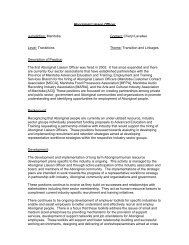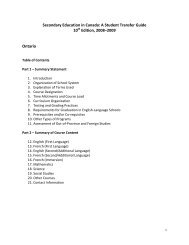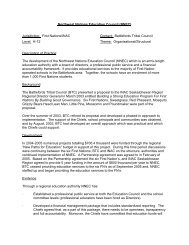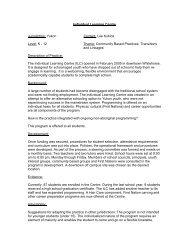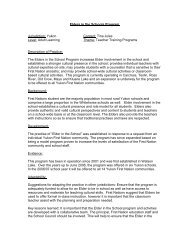highlights - Conseil des ministres de l'Ãducation du Canada (CMEC)
highlights - Conseil des ministres de l'Ãducation du Canada (CMEC)
highlights - Conseil des ministres de l'Ãducation du Canada (CMEC)
You also want an ePaper? Increase the reach of your titles
YUMPU automatically turns print PDFs into web optimized ePapers that Google loves.
manitoba• The Direction <strong><strong>de</strong>s</strong> ressources é<strong>du</strong>catives françaises [French-languagee<strong>du</strong>cation resources branch] (DREF) of the Bureau <strong>de</strong> l’é<strong>du</strong>cationfrançaise [French-language e<strong>du</strong>cation bureau] (BEF) acquire<strong>de</strong><strong>du</strong>cational and instructional materials for e<strong>du</strong>cation staff workingwith stu<strong>de</strong>nts from kin<strong>de</strong>rgarten to Gra<strong>de</strong> 12, and provi<strong>de</strong>d themwith the services of its library. This ma<strong>de</strong> over 63,000 Frenchlanguageresources available to the schools and to provincialresi<strong>de</strong>nts who were interested in them. In 2008–09, the BEF librarylent over 31,000 resources to teaching staff in the French schools.• The DSFM partnered with the Collège universitaire <strong>de</strong> Saint-Boniface(CUSB), Saint Boniface’s French-language university college, andwith the BEF Division of the Department of E<strong>du</strong>cation to supportthe <strong>de</strong>livery of Petites écoles en réseau [small networked schools](PEER), a course in sciences, to 24 Gra<strong>de</strong> 9 stu<strong>de</strong>nts in four smallrural schools. The stu<strong>de</strong>nts in these schools were brought togetherthrough virtual collaboration.• Francophone stu<strong>de</strong>nts wishing to pursue their studies in Frenchat the postsecondary level received financial support. In 2008–09,some 60 gra<strong>du</strong>ating stu<strong>de</strong>nts whose first language was Frenchreceived a bursary for this purpose. This was also the case for49 postsecondary stu<strong>de</strong>nts who wanted to take a program ofstudy in French that was not offered in Manitoba.HIGHLIGHTS OF ACHIEVEMENTS INSECOND-LANGUAGE INSTRUCTIONManitoba’s achievements in second-language instruction, between2005–06 and 2008–09, inclu<strong>de</strong>d the following outcomes supportedby fe<strong>de</strong>ral–provincial funding arrangements:• Enrolment in the French immersion program increased from17,604 stu<strong>de</strong>nts in 2005–06 to 18,563 in 2008–09, a gain of959 stu<strong>de</strong>nts or 5.4 per cent. The number of French immersionstu<strong>de</strong>nts who obtained their secondary school diploma increasedfrom 759 stu<strong>de</strong>nts in 2006 to 787 in 2009.• The Web sites of French for Life and French for Career Options,two projects <strong>de</strong>veloped by Canadian Parents for French – Manitoba,the Association manitobaine <strong><strong>de</strong>s</strong> directeurs d’immersion [Manitobaassociation of immersion directors], and the Manitoba Associationof Teachers of French, continue to enjoy enormous success inpromoting the learning of French.18Pan-Canadian Report on Official Languages in E<strong>du</strong>cation 2005–06 to 2008–09 HIGHLIGHTS






